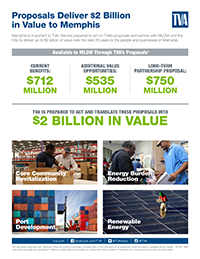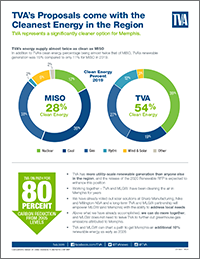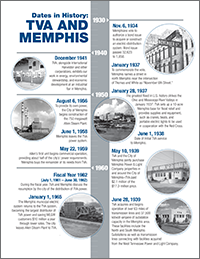Articles
More Value for Memphis
Memphis is important to TVA. We are prepared to act on TVA’s proposals and partner with MLGW and the City to deliver up to $2 billion of value over the next 20 years to the people and businesses of Memphis.
JULY 7, 2020 — Recently, TVA provided its input on MLGW’s Draft Integrated Resource Plan (IRP). TVA fully supports and acknowledges that Memphians deserve a reliable source of energy that is reasonably priced, environmentally sensitive, and provides long-term pricing stability. We expressed our specific concerns related to some of the assumptions and data within the IRP. While the IRP identifies a potential future savings of $122 million for Portfolio 9, we believe that it significantly underestimates the risks and likely costs. Based on our extensive experience constructing and operating power systems, and that of the utility industry in general, we believe it is much more likely that MLGW rates will ultimately be higher if the non-TVA option is selected. It is important to recognize that leaving TVA, a known system with an 80-year record of superior performance, to pursue savings that are neither guaranteed nor in our view likely, creates significant risk that the ratepayers of MLGW would ultimately bear.
While it is important to recognize the risk involved in leaving TVA, it is perhaps even more important to understand the significant additional value that TVA is committed to provide to Memphis if we continue our relationship. The information below was reviewed this week with MLGW and the City of Memphis.
Currently, 141 of our 153 local power companies, including Chattanooga, Nashville, Knoxville and Huntsville, have executed the long-term partner proposal. Benefits include:
- Immediate Annual Recurring $22.5 million Rate Credit to MLGW: MLGW will receive an immediate and ongoing 3.1% rate credit which can be applied against MLGW’s specific priorities. LPCs have used the credit to reduce rates, to accelerate renewable energy deployment, or to advance technology that increases reliability. This credit represents $22.5 million annually for MLGW and could be used to avoid some pending MLGW rate increases. This represents $450 million over the initial 20-year term of the agreement.
- Flexibility to Serve 3-5% of MLGW Energy: MLGW would have the flexibility to deploy a range of technologies to meet changing customer demands. For example, MLGW could install up to 200 MW of solar generation on its system under this program. This installation could save MLGW rate payers up to $15 million annually, or $300 million over the initial 20-year term of the agreement and support local renewable solutions for customers. We believe that through the Flexibility Program incorporated in the LTPP and other programs such as Green Invest, TVA and MLGW could develop solar generation to serve 10% of MLGW energy demand by 2026. Across the valley, LPCs such as Nashville and Knoxville, institutions such as Vanderbilt University, and businesses like General Motors have already begun to utilize these programs to help meet their sustainability goals.
Some of the benefits currently delivered through MLGW and TVA’s 80-year relationship include:
- The Power of Public Power: TVA, MLGW and the other 152 LPCs we serve were not built for profit — we were built for people. Service is at our collective core. Our focus on energy at the lowest feasible rate, environmental stewardship, and economic development is still the right focus as we face the future. Independent studies have shown that this public power model is the most appropriate for our region given the challenges we face.
- Financial Strength: TVA is strong financially and continues to improve its long-term financial health. We reduced our operating costs by over $800 million, our fuel costs by over $1 billion and our debt to the lowest level in 30 years. In fact, TVA’s debt relative to our assets is the lowest among our peers. This ensures that TVA can deliver on its commitments, effectively deal with emergent challenges, and can provide rate stability even during the uncertain times in which we live.
- Competitive and Stable Rates: Together, TVA and MLGW deliver the 6th lowest rates among the top 100 utilities, and the 3rd lowest rates among Memphis’s peer cities. TVA’s residential rates, which include base rates and fuel costs, have been flat for 7 years and our long-term financial plan projects flat rates for a decade. Our fuel costs have continued to decline and are presently at the lowest level in 14 years. Our industrial rates are lower than 90% of suppliers, helping to attract investment to the region. After reviewing our financial plan, the IRP concluded that TVA’s rates are likely to decrease, not increase, confirming our own projections.
- High Reliability: TVA has delivered 100% reliability to Memphis for over 20 consecutive years. Our 16,000-mile transmission system is one of the most reliable in the nation. We are continuing to invest to ensure we can support economic growth in Memphis and Shelby County at this same historic level of reliability. Currently, we have reliability projects valued at $72 million underway targeted at that objective.
- World Class Economic Development: TVA – in partnership with MLGW, the local community, and others — has attracted or retained over 40,000 jobs and $5.4 billion of investments to Memphis and Shelby County in just the last 8 years.
- Strong Environmental Stewardship: TVA produces over 54% of its energy from carbon free sources. Since 2005, we have reduced our greenhouse gas (GHG) emissions by 60%, and we have concrete plans for further significant reduction over the next decade. These reductions place us in the best 25% nationally. Our estimated carbon emissions are 40% less than MISO and lower than IRP Portfolio 9 across the entire 20-year horizon. We have the most renewable energy capacity in the southeast, and we expect to extend this with up to 14 GW of solar generation additions through a structured, cost effective strategy. TVA’s actions over the last decade were key to Memphis’s exit from non-attainment status, a critical economic development issue.
- Industry Leading Risk Management: TVA has one of the nation’s most diverse and balanced generation fleets, with one of the lowest delivered fuel costs. In addition to our diverse and low fuel cost generating portfolio, TVA is not tied to a single energy market. Rather, we operate a highly integrated transmission system with interconnections to the major markets and generating companies in the eastern United States. This allows us to purchase power at the lowest cost when needed. The scale of our operation ensures that equipment failures, natural disasters or man-made events will not jeopardize safety, reliability, or cost. Our experience and scale in the market allow us to build assets on time and at highly competitive prices. The strength of TVA as a provider and counterparty are key to attracting investment. Adverse events do and will occur. The level of risk mitigation delivered by TVA simply cannot be duplicated by MLGW and has significant value.
- Committed Community Engagement: TVA invests more than $71 million annually in the Memphis community in economic development, energy burden reduction, community support and tax equivalent payments. This investment is being delivered now and will continue if we maintain our relationship.
While not all of these benefits can be characterized solely in terms of dollars, they are all relevant to any decision MLGW may make. They are not all available in the model MLGW is considering and will be lost with
separation from TVA and our system.
Additional Value Opportunities Under the Current Contract:1
- Economic Development and Energy Burden Reduction: MLGW has some of the lowest electric rates in the country. However, energy burden remains high due to distribution-level reliability issues, lower than average household incomes and inefficient infrastructure. These problems are common in urban areas and remain largely unsolved. A TVA, MLGW, and Memphis community partnership focused in this area has the potential to produce solutions and to set an example for others to follow. To initiate this relationship, TVA would commit to a number of initiatives:
- TVA will continue to deliver expanded economic development opportunities. Increased efforts over the last year are already producing results such as the Amazon facility in Raleigh/Frayser and the AutoZone HQ expansion in downtown.
- TVA will work to disposition the Allen Fossil Site to enable the Port Development Project. We will prioritize the needed environmental assessments and decommissioning scope to help make the new port a reality. Similar port projects have generated over $5 billion in economic activity over a 10-year period.
- TVA will commit to assisting MLGW and Memphis in addressing revitalization of core communities by contributing up to $10 million per year for as many as 10 years. One way to amplify the benefits of these contributions would be to align with the four key goals of the City of Memphis and Shelby County’s Opportunity Zones.
- TVA will double its commitment to the successful Home Energy Uplift Program designed to significantly improve home energy efficient and livability for low income families.
- TVA will sponsor a forum to identify challenges and opportunities related to energy burden reduction and provide $3 million in matching funds toward the identified actions. For example, TVA believes that a project in partnership with Shelby County Schools to perform energy efficiency audits and retrofit schools with LED lighting would reduce costs and improve the student environment.
- TVA Presence in Memphis: TVA will commit to establish Memphis as TVA’s hub for core community revitalization and energy burden reduction resources. This could result in 100 full-time employees and an expansion of TVA’s Memphis headquarters.
- Renewable Energy Resource Deployment and Sustainability: TVA will commit to implement a staged approach to meeting Memphis’s renewable energy objectives using industry leading TVA programs. For example, we believe that programs such as Green Invest can be leveraged to allow TVA and MLGW to develop a significant amount of solar generation. TVA has an objective to support the electrification of transportation. We propose to collaborate with MLGW and Memphis to study and demonstrate the use of electric transit buses as a means to reduce GHG emissions and to improve local air quality.
- Financial Support Opportunities: TVA currently compensates MLGW for the use of its transmission system. TVA is willing to explore alternative financing arrangements for this compensation. For example, TVA
could purchase the MLGW transmission system and integrate it into the TVA system. The net present value to TVA of the transmission credits is in the range of $400 million. Sale of the system would allow MLGW to
reduce related operating and maintenance expenses, avoid future capital investment and could allow MLGW to reallocate capital into distribution system reliability improvements to reduce near-term ratepayer impacts. TVA would be
willing to provide a $100 million option payment (or alternative arrangement) while we jointly conduct due diligence. In the event the sale is not completed, the advance payment would be repaid to TVA over an agreed-upon timeline.
TVA is prepared to act on these proposals now and to join MLGW, Memphis, and the people of Shelby County in translating these proposals into as much as $2.0 billion of value that they represent.
1 For discussion purposes only and does not constitute a binding offer and shall not form the basis for an agreement under any legal or equitable theory. Subject to market and other conditions. Some of these proposed additional actions would require TVA Board approval and/or completion of necessary environmental reviews and so long as MLGW does not give notice to end its current contract.
Share this story: ' fill='%23414141'%3E%3Cpath d='M0 0h314v314H0z'/%3E%3C/g%3E%3Cg transform='translate(6 4)'%3E%3Cmask id='d' fill='%23fff'%3E%3Cuse xlink:href='%23c'/%3E%3C/mask%3E%3Cuse fill='%23FFF' xlink:href='%23c'/%3E%3Cg mask='url(%23d)' fill='%23FFF'%3E%3Cpath d='M-149-165h300v318h-300z'/%3E%3C/g%3E%3C/g%3E%3C/g%3E%3C/svg%3E%0A)
' fill='%23414141'%3E%3Cpath d='M0 0h314v314H0z'/%3E%3C/g%3E%3Cg transform='translate(4 5)'%3E%3Cmask id='d' fill='%23fff'%3E%3Cuse xlink:href='%23c'/%3E%3C/mask%3E%3Cuse fill='%23FFF' xlink:href='%23c'/%3E%3Cg mask='url(%23d)' fill='%23FFF'%3E%3Cpath d='M-167-171h323v327h-323z'/%3E%3C/g%3E%3C/g%3E%3C/g%3E%3C/svg%3E%0A)
' fill='%23414141'%3E%3Cpath d='M0 0h314v314H0z'/%3E%3C/g%3E%3Cg transform='translate(4.26 4)'%3E%3Cmask id='d' fill='%23fff'%3E%3Cuse xlink:href='%23c'/%3E%3C/mask%3E%3Cuse fill='%23FFF' xlink:href='%23c'/%3E%3Cg mask='url(%23d)' fill='%23FFF'%3E%3Cpath d='M-150-157h300v300h-300z'/%3E%3C/g%3E%3C/g%3E%3C/g%3E%3C/svg%3E)
Fact Sheets
Proposals Deliver $2 Billion in Value to Memphis (PDF)
TVA's Proposals Come with Cleanest Energy in the Region (PDF)
Dates in History: TVA and Memphis (PDF)
What Happened When They Left?
Two other local power companies—Bristol, Virginia, and Paducah, Kentucky—left the TVA service region for other power providers, and had wildly different experiences and outcomes. Read about them below:


